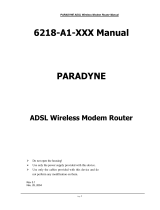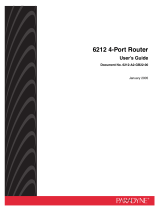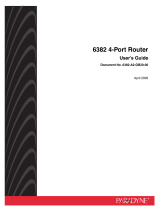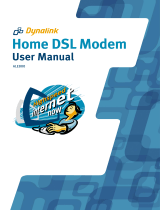Page is loading ...

Hotwire
®
6212 ADSL Router
User’s Guide
Document Number 6212-A2-GB20-20
July 2004

2 July 2004 6212-A2-GB20-20
Copyright © 2004 Paradyne Corporation.
All rights reserved.
Printed in U.S.A.
Notice
This publication is protected by federal copyright law. No part of this publication may be copied or distributed,
transmitted, transcribed, stored in a retrieval system, or translated into any human or computer language in any form
or by any means, electronic, mechanical, magnetic, manual or otherwise, or disclosed to third parties without the
express written permission of Paradyne Corporation, 8545 126th Ave. N., Largo, FL 33773.
Paradyne Corporation makes no representation or warranties with respect to the contents hereof and specifically
disclaims any implied warranties of merchantability or fitness for a particular purpose. Further, Paradyne Corporation
reserves the right to revise this publication and to make changes from time to time in the contents hereof without
obligation of Paradyne Corporation to notify any person of such revision or changes.
Changes and enhancements to the product and to the information herein will be documented and issued as a new
release to this manual.
Warranty, Sales, Service, and Training Information
Contact your local sales representative, service representative, or distributor directly for any help needed. For
additional information concerning warranty, sales, service, repair, installation, documentation, training, distributor
locations, or Paradyne worldwide office locations, use one of the following methods:
• Internet: Visit the Paradyne World Wide Web site at www.paradyne.com. (Be sure to register your warranty at
www.paradyne.com/warranty.)
• Telephone: Call our automated system to receive current information by fax or to speak with a company
representative.
Within the U.S.A., call 1-800-870-2221
Outside the U.S.A., call 1-727-530-2340
Document Feedback
We welcome your comments and suggestions about this document. Please mail them to Technical Publications,
Paradyne Corporation, 8545 126th Ave. N., Largo, FL 33773, or send e-mail to [email protected]. Include the
number and title of this document in your correspondence. Please include your name and phone number if you are
willing to provide additional clarification.
Trademarks
Acculink, Comsphere, ETC, Etherloop, FrameSaver, GranDSLAM, Hotwire, the Hotwire logo, Jetstream, MVL,
NextEDGE, OpenLane, Paradyne, the Paradyne logo, Paradyne Credit Corp., the Paradyne Credit Corp. logo,
Performance Wizard, StormPort, TruPut are all registered trademarks of Paradyne Corporation. ADSL/R, BitStorm,
Connect to Success, GrandVIEW, Hotwire Connected, iMarc, JetFusion, JetVision, MicroBurst, PacketSurfer,
ReachDSL, Spectrum Manager, StormTracker and TriplePlay are trademarks of Paradyne Corporation. All other
products and services mentioned herein are the trademarks, service marks, registered trademarks, or registered
service marks of their respective owners.
CE Marking
When the product is marked with the CE mark on the equipment label, a supporting Declaration of Conformity may be
downloaded from the Paradyne World Wide Web site at www.paradyne.com. Select Library → Technical Manuals →
CE Declarations of Conformity.

6212-A2-GB20-20 July 2004 3
Important Safety Instructions
1. Read and follow all warning notices and instructions marked on the product or included in the manual.
2. Slots and openings in the cabinet are provided for ventilation. To ensure reliable operation of the product
and to protect it from overheating, these slots and openings must not be blocked or covered.
3. Do not allow anything to rest on the power cord and do not locate the product where persons will walk
on the power cord.
4. Do not attempt to service this product yourself, as opening or removing covers may expose you to
dangerous high voltage points or other risks. Refer all servicing to qualified service personnel.
5. General purpose cables are used with this product for connection to the network. Special cables, which
may be required by the regulatory inspection authority for the installation site, are the responsibility of
the customer. Use a UL Listed, CSA certified, minimum No. 24 AWG line cord for connection to the
Digital Subscriber Line (DSL) network.
6. When installed in the final configuration, the product must comply with the applicable Safety Standards
and regulatory requirements of the country in which it is installed. If necessary, consult with the
appropriate regulatory agencies and inspection authorities to ensure compliance.
7. A rare phenomenon can create a voltage potential between the earth grounds of two or more buildings.
If products installed in separate buildings are interconnected, the voltage potential may cause a
hazardous condition. Consult a qualified electrical consultant to determine whether or not this
phenomenon exists and, if necessary, implement corrective action prior to interconnecting the products.
8. Input power to this product must be provided by one of the following: (1) a UL Listed/CSA certified
power source with a Class 2 or Limited Power Source (LPS) output for use in North America, or (2) a
certified transformer, with a Safety Extra Low Voltage (SELV) output having a maximum of 240 VA
available, for use in the country of installation.
9. In addition, since the equipment is to be used with telecommunications circuits, take the following
precautions:
— Never install telephone wiring during a lightning storm.
— Never install telephone jacks in wet locations unless the jack is specifically designed for wet locations.
— Never touch uninsulated telephone wires or terminals unless the telephone line has been
disconnected at the network interface.
— Use caution when installing or modifying telephone lines.
— Avoid using a telephone (other than a cordless type) during an electrical storm. There may be a
remote risk of electric shock from lightning.
— Do not use the telephone to report a gas leak in the vicinity of the leak.

4 July 2004 6212-A2-GB20-20
CE Marking
When the product is marked with the CE mark on the equipment label, a supporting Declaration of
Conformity may be downloaded from the Paradyne World Wide Web site at www.paradyne.com. Select
Support -> Technical Manuals -> Declarations of Conformity.
FCC Part 15 Declaration
An FCC Declaration of Conformity may be downloaded from the Paradyne World Wide Web site at
www.paradyne.com. Select Support -> Technical Manuals -> Declarations of Conformity.
This device complies with Part 15 of the FCC Rules. Operation is subject to the following two conditions: (1)
this device may not cause harmful interference, and (2) this device must accept any interference received,
including interference that may cause undesired operation.
The authority to operate this equipment is conditioned by the requirement that no modifications will be
made to the equipment unless the changes or modifications are expressly approved by the responsible
party.
This equipment has been tested and found to comply with the limits for a Class B digital device, pursuant
to Part 15 of the FCC Rules. These limits are designed to provide reasonable protection against harmful
interference in a residential installation. This equipment generates, uses, and can radiate radio frequency
energy and, if not installed and used in accordance with the instructions, may cause harmful interference
to radio communications. However, there is no guarantee that interference will not occur in a particular
installation. If this equipment does cause harmful interference to radio or television reception, which can
be determined by turning the equipment off and on, the user is encouraged to try to correct the
interference by one or more of the following measures:
• Reorient or relocate the receiving antenna.
• Increase the separation between the equipment and receiver.
• Connect the equipment into an outlet on a circuit different from that to which the receiver is connected.
• Consult the dealer or an experienced radio/TV technician for help.

6212-A2-GB20-20 July 2004 5
Notice to Users of the United States Telephone Network
The following notice applies to versions of the modem that have been FCC Part 68 approved.
This equipment complies with Part 68 of the FCC rules and the requirements adopted by the
Administrative Council for Terminal Attachment (ACTA). On the bottom side of this equipment is a label
that contains, among other information, a product identifier in the format US:AAAEQ##TXXXX. If
requested, this number must be provided to the Telephone Company.
This equipment is intended to connect to the Public Switched Telephone Network through a Universal
Service Order Code (USOC) type RJ11C jack. A plug and jack used to connect this equipment to the
premises wiring and telephone network must comply with the applicable FCC Part 68 rules and
requirements adopted by the ACTA. A compliant telephone cord and modular plug is provided with this
product. It has been designed to be connected to a compatible modular jack that is also compliant.
The Ringer Equivalence Number (or REN) is used to determine the number of devices that may be
connected to a telephone line. Excessive RENs on a telephone line may result in the devices not ringing in
response to an incoming call. In most but not all areas, the sum of RENs should not exceed five (5.0). To
be certain of the number of devices that may be connected to a line, as determined by the total RENs,
contact the local Telephone Company. The REN for this product is part of the product identifier that has the
format US:AAAEQ##TXXXX. The digits represented by ## are the REN without a decimal point. For
example, 03 represents a REN of 0.3.
If the modem causes harm to the telephone network, the Telephone Company will notify you in advance
that temporary discontinuance of service may be required. But if advance notice is not practical, the
Telephone Company will notify the customer as soon as possible. Also, you will be advised of your right to
file a complaint with the FCC if you believe it is necessary.
The Telephone Company may make changes in its facilities, equipment, operations or procedures that
could affect the operation of the equipment. If this happens, the Telephone Company will provide advance
notice in order for you to make necessary modifications to maintain uninterrupted service. If trouble is
experienced with the modem, refer to the repair and warranty information in this document.
If the equipment is causing harm to the telephone network, the Telephone Company may request that you
disconnect the equipment until the problem is resolved.
The user may make no repairs to the equipment.
Connection to party line service is subject to state tariffs. Contact the state public utility commission, public
service commission or corporation commission for information.
If the site has specially wired alarm equipment connected to the telephone line, ensure the installation of
the modem does not disable the alarm equipment. If you have questions about what will disable alarm
equipment, consult your Telephone Company or a qualified installer.

6 July 2004 6212-A2-GB20-20
Notice to Users of the Canadian Telephone Network
NOTICE: This equipment meets the applicable Industry Canada Terminal Equipment Technical
Specifications. This is confirmed by the registration number. The abbreviation IC before the registration
number signifies that registration was performed based on a Declaration of Conformity indicating that
Industry Canada technical specifications were met. It does not imply that Industry Canada approved the
equipment.
NOTICE: The Ringer Equivalence Number (REN) for this terminal equipment is labeled on the equipment.
The REN assigned to each terminal equipment provides an indication of the maximum number of
terminals allowed to be connected to a telephone interface. The termination on an interface may consist of
any combination of devices subject only to the requirement that the sum of the Ringer Equivalence
Numbers of all the devices does not exceed five.
If your equipment is in need of repair, contact your local sales representative, service representative, or
distributor directly.
CANADA – EMI NOTICE:
This Class B digital apparatus meets all requirements of the Canadian interference-causing equipment
regulations.
Cet appareil numérique de la classe B respecte toutes les exigences du règlement sur le matérial
brouilleur du Canada.
Japan Notices

6212-A2-GB20-20 July 2004 7
Table of Contents
Chapter 1 Introduction ....................................................10
1.1 Product Overview.............................................................. 10
1.2 Features .......................................................................... 11
1.3 Application....................................................................... 12
1.4 Front Panel LED Indicators.................................................. 13
Chapter 2 Hardware Installation......................................14
2.1 Installation....................................................................... 14
2.2 Installing the USB Driver.................................................... 15
2.2.1 Auto Installation................................................................ 16
2.2.2 Manual Installation............................................................ 18
2.3 Uninstalling the USB Driver................................................. 25
2.3.1 Auto-Uninstallation............................................................ 25
2.3.2 Manual Removal of the Driver ............................................. 27
Chapter 3 Login Via the Web Browser..............................28
3.1 IP Address ....................................................................... 28
3.2 Login Procedure................................................................ 29
Chapter 4 Basic Configuration..........................................30
4.1 Software Version Information.............................................. 30
4.2 Change the Password......................................................... 31
4.3 ADSL Link Status .............................................................. 32
4.4 WAN Setup....................................................................... 33
4.4.1 RFC 1483 Bridged ............................................................. 34
4.4.2 RFC 1483 Routed .............................................................. 34
4.4.3 PPPoE.............................................................................. 35
4.4.4 PPPoA.............................................................................. 36
4.4.5 MER ................................................................................ 36
4.5 LAN IP Address................................................................. 36
4.6 Routing............................................................................ 37
4.6.1 Enable RIP ....................................................................... 37
4.6.2 Static route configuration ................................................... 38
4.7 Save ............................................................................... 40
4.8 Reboot............................................................................. 40
4.9 Retrieve default settings..................................................... 41
Chapter 5 Advanced Configuration...................................42
5.1 ADSL Mode....................................................................... 42
5.2 VLAN............................................................................... 43

8 July 2004 6212-A2-GB20-20
5.3 DHCP .............................................................................. 43
5.3.1 Enable DHCP .................................................................... 44
5.3.2 Disable the DHCP.............................................................. 46
5.4 DHCP Relay...................................................................... 46
5.5 SNMP .............................................................................. 47
5.5.1 Modifying SNMP Parameters................................................ 47
5.5.2 Modifying Traps ................................................................ 48
5.5.3 Modifying Communities...................................................... 49
5.6 Firewall............................................................................ 50
5.6.1 View Firewall Actions ......................................................... 51
5.6.2 IP Filtering ....................................................................... 52
5.7 NAT................................................................................. 54
5.7.1 Static NAT Mapping ........................................................... 54
5.7.2 Port Range Mapping........................................................... 55
5.8 Configure......................................................................... 56
5.8.1 Configure Interface............................................................ 57
5.8.2 DNS & Default Gateway ..................................................... 59
5.8.3 NAT................................................................................. 60
5.9 VCC ................................................................................ 61
5.9.1 List IPoA.......................................................................... 61
5.9.2 Delete Encapsulation ......................................................... 62
5.9.3 Add a VCC........................................................................ 62
5.9.4 Delete a VCC.................................................................... 65
5.9.5 Show VCC quality.............................................................. 65
5.9.6 PPPoE.............................................................................. 65
5.9.7 PPPoA.............................................................................. 66
5.10 IGMP............................................................................... 67
5.10.1 Add an IGMP entry ............................................................ 67
5.10.2 Delete an IGMP entry......................................................... 68
5.11 Bridging........................................................................... 68
5.11.1 Bridge ............................................................................. 68
5.11.2 Spanning tree................................................................... 70
5.11.3 View STP parameters......................................................... 71
5.11.4 To configure STP parameters .............................................. 72
5.11.5 Enable/Disable STP............................................................ 72
Chapter 6 Performance monitoring ..................................73
6.1 ADSL Link Status .............................................................. 73
6.2 System Statistics .............................................................. 74
6.2.1 Interface Statistics ............................................................ 74
6.2.2 TCP-IP............................................................................. 76

6212-A2-GB20-20 July 2004 9
6.2.3 DHCP-Lease ..................................................................... 77
6.3 ATM statistics ................................................................... 77
6.3.1 AAL5 ............................................................................... 77
6.3.2 Encapsulation ................................................................... 78
Chapter 7 Diagnostics ......................................................79
7.1 OAM Loopback.................................................................. 79
7.2 Ping ................................................................................ 80
Chapter 8 Firmware Upgrade ...........................................82
8.1 TFTP Upgrade Via Web....................................................... 82
8.2 Upgrade Via FTP................................................................ 83
Chapter 9 Accessing the Logging Record .........................85
9.1 Log Record from Telnet...................................................... 85
Appendix A: Specifications ...............................................89
Appendix B: Pin Assignments ...........................................91
Appendix C: Troubleshooting............................................92
Glossary ....................................................................93

10 July 2004 6212-A2-GB20-20
Chapter 1 Introduction
This chapter introduces the Hotwire
®
6212 ADSL Router. It includes a product overview, a
description of the product’s features and applications, and an explanation of the functions of
the Front panel LED indictors.
1.1 Product Overview
The Hotwire 6212 ADSL Router is an ADSL router integrated with a USB and an Ethernet
Interface. The USB and four Ethernet ports can be used simultaneously, allowing a total of five
PCs to be connected to the Hotwire 6212 and access the ADSL line. In addition, the Hotwire
6212 can be configured to operate in bridge mode or router mode.
The auto configuration/auto upgrade function allows multiple ADSL routers to be upgraded
over the LAN in one operation.
The Hotwire 6212 protects all of your networked computers with advanced security
technologies such as virtual private networks (VPNs) with PPTP passthrough, L2TP
passthrough, and IPSec passthrough.

6212-A2-GB20-20 July 2004 11
1.2 Features
The ADSL Router is a compact and high performance standalone unit that provides:
Four Ethernet ports and one USB port for LAN connection
One console port for local management
Stateful packet inspection and filtering
Denial of Service protection
IGMP Proxy
G.dmt, G.lite, and T1.413
Remote configuration and upgrade
Auto-negotiation rate adaptation
AAL5 for ATM over ADSL
UBR, CBR, VBR-real-time, VBR-non-realtime ATM services
VC-based and LLC multiplexing
Up to 8 VCs
Embedded SNMP agent
Configuration backup and restoration
OAM F4/F5
Static route/RIP/RIP v2 routing functions
NAT/PAT
On-demand PPPoE
PVC can support multiple PPPoE sessions
DHCP Server/Relay
DNS Proxy
FTP Server
TFTP Client
IEEE 802.1d compliant

12 July 2004 6212-A2-GB20-20
1.3 Application
The figure below shows a possible application of the router.

6212-A2-GB20-20 July 2004 13
1.4 Front Panel LED Indicators
LED Indicator Color Mode Function
Green On Power is supplied Power
Off Power is not supplied
On An Ethernet link is established
Off An Ethernet link is not established
LAN 1x – 4x Green
Flash Activity over the Ethernet link
On A USB link is connected USB Green
Off A USB link is not connected
Flash The ADSL Link is training
On The ADSL Link is established
ADSL Link Green
Off The ADSL link is not connected
Flash Packets transmitted or received on the ADSL link ADSL TX/RX Green
Off No packets on the ADSL link

14 July 2004 6212-A2-GB20-20
Chapter 2 Hardware Installation
2.1 Installation
The Hardware installation procedure is explained below.
Caution: Always disconnect all telephone lines from the telephone wall outlet before
servicing or disassembling this device.
1. Verify that the On/Off switch on the rear panel is in the Off position.
2. Connect the power adapter to the Power jack of the device, and then plug
the power adapter into the wall outlet.
3. Connect the USB port to a PC with a standard USB cable.
4. Connect the LAN ports to PCs or a hub using RJ45 cables. The LAN ports
automatically sense whether the connection requires a crossover, so either
straight-through or crossover cables may be used.
5. Connect the LINE port to your telephone jack with an RJ11 connector cable.
6. Turn the On/Off switch on the rear panel to the On position.
Note If the device fails to power on, or it malfunctions, first verify that the power supply
is correctly connected, and then power it on again.

6212-A2-GB20-20 July 2004 15
2.2 Installing the USB Driver
Before you connect your router’s USB cable to your PC, you must load the ADSL USB drivers
and configure the device via the LAN port using Web management. There are two ways to
install the USB driver:
• Auto-installation: Install the driver by inserting the CD in the CD drive of your PC and
letting the installation automatically start.
• Manual installation: Install the driver with the Windows Hardware Wizard. When using the
USB port the LAN port must be vacant.

16 July 2004 6212-A2-GB20-20
2.2.1 Auto Installation
STEP 1: Insert the CD-ROM disc for the ADSL USB router.
STEP 2:
The CD-ROM will auto-play and you will see the following screen. Click on Next to
continue. (If the screen doesn’t appear, browse the CD-ROM and double-click on
INSTALL.EXE.)

6212-A2-GB20-20 July 2004 17
STEP 3: When prompted by the message shown below, connect your router to a USB port of
your PC. Then click on OK.
STEP 4:
A completion message appears when the installation is complete. Click on Finish.

18 July 2004 6212-A2-GB20-20
2.2.2 Manual Installation
To connect the router to a PC using the USB interface, you need to use a standard USB cable
and install the USB interface software. Follow the steps below.
STEP 1
: Connect the USB router to the PC by plugging the flat connector of a standard USB
cable into a USB port on your PC, and plugging the square connector into the router. The Found
New Hardware screen appears:
STEP 2
: When the screen appears as below, click on the Next button.

6212-A2-GB20-20 July 2004 19
STEP 3: When the screen appears as below, select Search for a suitable driver and click the
Next button.

20 July 2004 6212-A2-GB20-20
STEP 4: Select Specify a location and click on the Next button. If you are installing the
software from a disk, insert the disk.
STEP 5
: Select the location of the file using the Browse button.
/









